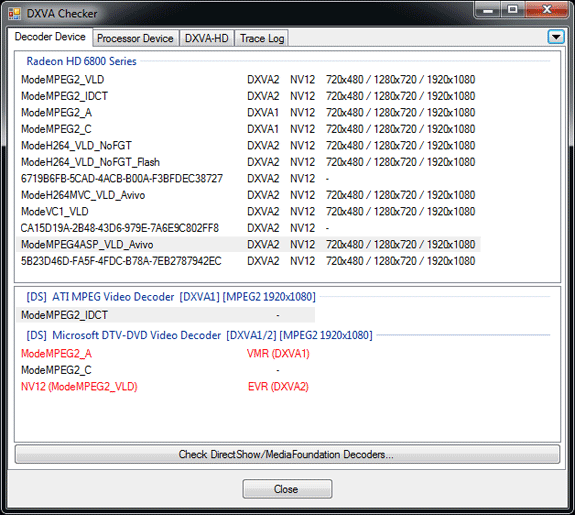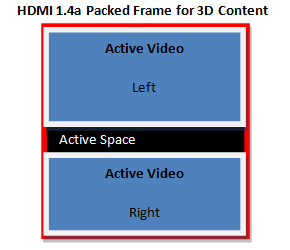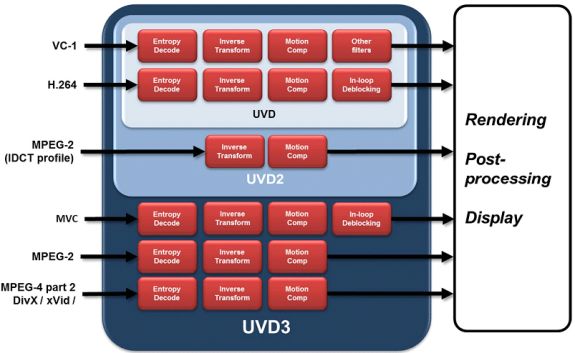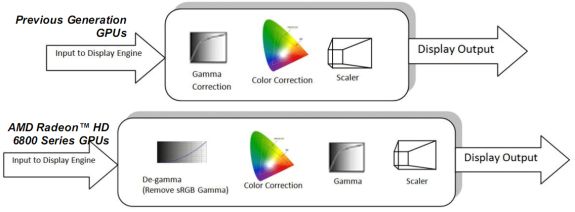AMD’s Radeon HD 6870 & 6850: Renewing Competition in the Mid-Range Market
by Ryan Smith on October 21, 2010 10:08 PM ESTSeeing the Present: HDMI 1.4a, UVD3, and Display Correction
DisplayPort wasn’t the only aspect of AMD’s display controller that got an overhaul however, AMD’s HDMI capabilities have also been brought up to modern standards. Coming from Cypress with support for HDMI 1.3, AMD now supports HDMI 1.4a on the Barts based 6800 series and presumably they will do so on the rest of the 6800 series too. With HDMI 1.4a support AMD can now support full resolution (1080p) 3D stereoscopy for movies, and 720p for games and other material that require 60Hz/eye, along with 4k x 2k resolution for monitors and TVs that have equivalent support. Unlike DP this has less to do with monitors and more to do with TVs, so the importance of this will be seen more on future AMD cards when AMD refreshes their lower-end parts that we normally use with HTPCs.
Launching alongside support for displaying full resolution 3D stereoscopic video is the hardware necessary to decode such video, in the form of the latest version of AMD’s Unified Video Decoder: UVD3. The last time UVD received a major update was with UVD2, which launched alongside the Radeon HD 4000 series and added partial MPEG-2 decoding support by moving IDCT and MoComp from shaders in to the UVD fixed function hardware.
With the Radeon 6800 series AMD is releasing UVD3, which like UVD2 before it builds on the existing UVD feature set. UVD3 is adding support for 3 more-or-less new codecs: MPEG-2, MVC, and MPEG-4 ASP (better known as DivX/XviD). Starting with MPEG-4 ASP, it’s the only new codec in supported by UVD3 that’s actually new, as previously all MPEG-4 ASP decoding was done in software when it came to AMD GPUs. With UVD3 AMD can now completely offload MPEG-4 ASP decoding to the GPU, bringing forth the usual advantages of greatly reducing the amount of work the CPU needs to do and ideally reducing power consumption in the process.
AMD adding MPEG-4 ASP support gives us an interesting chance to compare and contrast them to NVIDIA, who added similar support a year ago in the GT21x GPUs. AMD is a good bit behind NVIDIA here, but they’re making up for it by launching with much better software support for this feature than NVIDIA did; NVIDIA still does not expose their MPEG-4 ASP decoder in most situations, and overall did a poor job of advertising it. When we talked with DivX (who is AMD’s launch partner for this feature) they didn’t even know that NVIDIA had MPEG-4 ASP support. Meanwhile AMD is launching with DivX and had a beta version of the DivX codec with UVD3 support ready to test, and furthermore AMD is fully exposing their MPEG-4 ASP capabilities in their drivers as we see in this DXVA Checker screenshot.

The only downside at this time is that even with Microsoft’s greater focus on codecs for Windows 7, Windows 7 doesn’t know what to do with DXVA acceleration of MPEG-4 ASP. So while Win7 can play MPEG-4 ASP in software, you’re still going to need a 3rd party codec like the DivX codec to get hardware support for MPEG-4 ASP.
The other bit worth mentioning is that while AMD is launching support for MPEG-4 ASP decoding here on the 6800 series, much like HDMI 1.4a it’s not going to be a big deal for the 6800 series market. MPEG-4 ASP is a fairly lightweight codec, so support for it is going to be a bigger deal on low-end products, particularly AMD’s APUs if Llano and Bobcat end up using UVD3, as MPEG-4 ASP decoding in software requires a much greater share of resources on those products.
Up next is MPEG-2, which has been a codec stuck in limbo for quite some time over at AMD. MPEG-2 is even older and easier to decode than MPEG-4 ASP, and while GPUs have supported MPEG-2 decode acceleration as early as last decade, CPUs quickly became fast enough that when combined with low levels of hardware decode acceleration (inverse discrete cosine transform) was more than enough to play MPEG-2 content. Thus AMD hasn’t done much with MPEG-2 over the years other than moving IDCT/MoComp from the shaders to UVD for UVD2.
Because of the similarities between MPEG-4 ASP and MPEG-2, when AMD added support for full MPEG-4 ASP decode acceleration they were able to easily add support for full MPEG-2 decode acceleration, as they were able to reuse the MPEG-4 ASP entropy decode block for MPEG-2. As a result of including full MPEG-4 ASP decode acceleration, AMD now supports full MPEG-2 decode acceleration. Even more so than MPEG-4 ASP however, the benefits for this are going to lie with AMD’s low-end products where getting MPEG-2 off of the CPU should be a boon for battery life.

The final addition to UVD3 is support for Multiview Video Coding, which isn’t a new codec per se, but rather is an extension to H.264 for 3D stereoscopy. H.264 needed to be amended to support the packed frame formats used to store and transmit 3D stereoscopic videos, so with UVD3 AMD is adding support for MVC so that UVD can handle Blu-Ray 3D.
Finally, coupled with support for new codecs and new display outputs in AMD’s display controller is a refinement of AMD’s existing color correction capabilities in their display controller. Cypress and the rest of the 5000 series could do color correction directly on their display controllers, but they could only do so after gamma correction was applied, meaning they had to work in the non-linear gamma color space. Technically speaking this worked, but color accuracy suffered as a result. With the 6800 series’ new display controller, AMD can now perform color calibration in linear space by converting the image from gamma to linear color space for the color correction, before converting it back to gamma color space for display purposes.
As color correction is being used to correct for wide-gamut monitors the importance of this change won’t be seen right away for most users, but as wide-gamut monitors become more widespread color correction becomes increasingly important since wide-gamut monitors will misinterpret the normal sRGB colorspace that most rendering is done in.












197 Comments
View All Comments
Goty - Friday, October 22, 2010 - link
Other reviews show 6850s hitting 1GHz+ with software voltage modification, so I don't think that will be an issue.karlostomy - Monday, October 25, 2010 - link
The question then is, why did anandtech choose to include the EVGA card that NVIDIA no doubt hand picked and delivered?Including the OC 460 card is one thing, but at the very least some 'attempt' at oc'ing the 6850 would have retained a semblance of reviewer impartiality.
wyvernknight - Friday, October 22, 2010 - link
According to this article i just read it can do 6 way eyefinity.http://www.semiaccurate.com/2010/10/21/amds-6870-b...
The diagram is close to the bottom.
notty22 - Friday, October 22, 2010 - link
The reviewer addressed why the 460 o/c was included. Owners/gamers are reporting the ability to clock their 460's to the 810,820,850 mhz the clocks various "special" models come @ with stock voltage. I agree , its more of why did Nvidia do this ? Imho, it was to position the card without competing/obsoleting the gtx 465/470. Now that Nvidia has lowered the prices, and the good price point the new AMD cards launched with, this is a exciting time for the gamer.Now lets get some new, more powerful dx11 games !
Thanx for the COMPLETE review !
Kyanzes - Friday, October 22, 2010 - link
I could have sworn that AvP had been mentioned as a future standard test game on Anandtech. I could be wrong ofc.3DVagabond - Friday, October 22, 2010 - link
I'm really surprised you went along with using the EVGA (OC) card nVidia sent you. They sent you what is commonly referred to as "a ringer", and you went along. You should have used the stock 460 (both models) and a stock 470, IMO. Why let nVidia name the conditions? They are obviously going to do everything they can to tilt the playing field. Was there anything else they wanted that you did for them?AnandThenMan - Friday, October 22, 2010 - link
Well in the article, they basically admitted to "caving in" to Nvidia by including the overclocked card. Obviously Nvidia was very keen to have a specific card included, seems dubious."However with the 6800 launch NVIDIA is pushing the overclocked GTX 460 option far harder than we’ve seen them push overclocked cards in the past –we had an EVGA GTX 460 1GB FTW on our doorstep before we were even back from Los Angeles."
I mean stating, "a matter of editorial policy" then ignoring that policy outright seems pretty sketchy to me. Like you said, makes one question the results in general.
DominionSeraph - Friday, October 22, 2010 - link
If AMD's official segmentation strategy were to put a factory overclocked 6870 against the GTX 470, what would be the issue with AnandTech comparing the two? Granted, it doesn't mean much to enthusiasts who would just buy a stocker and overclock it to pocket the price differential, but I'd wager a card bought by your average idiot buying off the shelves of Best Buy isn't going to see anything other than the factory clocks.bji - Friday, October 22, 2010 - link
Actually the people overclocking their video cards and then dealing with overheating and loud-as-an-aircraft-engine fan noise are the idiots.Just thought that if you were going to go around saying disparaging things about people who have different values than you do, that you might appreciate some of the same.
spigzone - Friday, October 22, 2010 - link
Maybe if you had dropped testing the FTW 460 for the time being, saving it for your 'overview' test next week, you would have had enough time to release a fully fleshed out and organized review instead of letting Nvidia jerk you around, compromising your own 'editorial policy' on only using stock cards in the initial review and saving you the time and trouble of coming up with lame @$$ rationalizations.